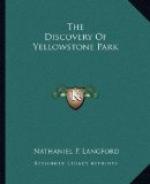We traveled down Trail creek and over a spur of the mountain to the valley of the Yellowstone, which we followed up eight miles to our present camp. Along on our right in passing up the valley was a vast natural pile of basaltic rock, perpendicular, a part of which had been overthrown, showing transverse seams in the rock. Away at the right in the highest range bordering the valley was Pyramid mountain, itself a snow-capped peak; and further up the range was a long ridge covered with deep snow. As we passed Pyramid mountain a cloud descended upon it, casting its gloomy shadow over the adjacent peaks and bursting in a grand storm. These magnificent changes in mountain scenery occasioned by light and shade during one of these terrific tempests, with all the incidental accompaniments of thunder, lightning, rain, snow and hail, afford the most awe-inspiring exhibition in nature. As I write, another grand storm, which does not extend to our camp, has broken out on Emigrant peak, which at one moment is completely obscured in darkness; at the next, perhaps, brilliant with light; all its gorges, recesses, seams and canons illuminated; these fade away into dim twilight, broken by a terrific flash, and, echoing to successive peals,
“* * * the rattling crags among
Leaps the live thunder” in innumerable
reverberations.
On the left of the valley the foot hills were mottled with a carpet of beautiful, maroon-colored, delicately-tinted verdure, and towering above all rose peak on peak of the snow-capped mountains.
To-day we saw our first Indians as we descended into the valley of the Yellowstone. They came down from the east side of the valley, over the foot hills, to the edge of the plateau overlooking the bottom lands of the river, and there conspicuously displayed themselves for a time to engage our attention. As we passed by them up the valley they moved down to where their ponies were hobbled. Two of our party, Hauser and Stickney, had dropped behind and passed towards the north to get a shot at an antelope; and when they came up they reported that, while we were observing the Indians on the plateau across the river, there were one hundred or more of them watching us from behind a high butte as our pack-train passed up the valley. As soon as they observed Hauser and Stickney coming up nearly behind them, they wheeled their horses and disappeared down the other side of the butte.[B] This early admonition of our exposure to hostile attack, and liability to be robbed of everything, and compelled on foot and without provisions to retrace our steps, has been the subject of discussion in our camp to-night, and has renewed in our party the determination to abate nothing of our vigilance, and keep in a condition of constant preparation.
[Illustration: On guard. Valley of the Yellowstone.]
With our long-range rifles and plenty of ammunition, we can stand off 200 or 300 of them, with their less efficient weapons, if we don’t let them sneak up upon us in the night. If we encounter more than that number, then what? The odds will be against us that they will “rub us out,” as Jim Stuart says.




